The flight to Scopje (do not pronounce the “j”), Macedonia took almost two days. I left on a Tuesday overnight to London. Arrived around 1:00 p.m. local time with a connection the next morning at the horrible hour of 6:00 a.m. through Vienna. I finally arrived at 12:30 p.m. on Thursday (3:30 a.m. Seattle time).
I will say that the trip from London to Scopje was made far more enjoyable by two women from Toronto, Joan and Pat, who were on the same flights as me. They were joining a tour group whereas I was definitely not. (Anyone who has read my blog knows my aversion to tour groups. Not because tour groups aren’t a great way to travel … I just don’t want to wait around for that many people).
Anyway, my driver Dean (pronounced Dionne, but he finally gave up and now just goes by Dean since so many Westerners kept getting it wrong), met me at the arrivals area and we were off to the center of Scopje where I would be staying. In fact, my hotel, the Alexander Square, a small locally owned boutique hotel, could not have been more centrally located right off the main town square known by, what else, Alexander Square.

Once settled, I decided to go for a walk, but only lasted about an hour in the rather hot weather (mid 30s or 90 plus degrees) before I gave in to exhaustion. The walk did, however, give me enough time to take a quick look at the main square and walk by a myriad of statutes and sculptures that can be found all over the main part of the city.

Anyway, I would have more time to visit the area tomorrow. So I wandered back to my hotel and took a 3 hour nap before meeting my guide Jane (pronounce Yawnee) for dinner. I quickly learned that Jane was all about food and as a result, we would not be going to any touristy restaurant that you find all over Alexander Square. Nope, we ended up walking west of my hotel down a number of cobblestone alleys, across a couple of very busy streets before turning down yet another alley to reach what I can only describe as local restaurant row. Little tables littered the alley outside one story buildings housing the myriad of restaurants.
We had no sooner turned down restaurant row before Jane was directing me to a restaurant owned by the family who lived next door to him when he was growing up. Once we were seated at a table the onslaught of food began. First up was the meze (pronounced Meza here) including grilled bread, pundyar (a red pepper based spread), Alvar (a red pepper relish that was to die for) and two kinds of cheeses (one from sheep’s milk and one from cow’s milk with the latter being grilled). Then came the main courses (that’s right, plural): zucchini mousaka along with pork & chicken vodno (meat in a red sauce of tomatoes and peppers). Of course there was also wine followed by the most fabulous baklava with walnuts. (The food here is heavily influenced by the Turks since the Ottoman Empire ruled this area until the early 1900s.
I cannot begin to describe how delicious the food was and by the end I was completely stuffed. Thankfully, we got to walk back to my hotel because I wasn’t sure I would be able to sleep after everything I ate, but damn it was good.
So once back at the hotel Jane suggested I skip breakfast at the hotel in the morning and he would take me to a shop for a traditional Macedonian breakfast. All right then. Once in my room, it was all I could do to crawl into bed and thankfully slept a glorious 9 hours.
I met Jane just after 9:00 a.m. and we set out in the beautiful morning sunshine to find a little pastry shop close to my hotel. I soon learned that pastry seems to be a way of life here with bakeries dominating virtually every street corner. Every other shop we passed seemed to have some sort of pastry for sale. And these are not the kinds of pastries you will find in North America. No doughnuts here. Instead, many of the pastries called “burek” are made of phyllo dough and stuffed with an array of ingredients
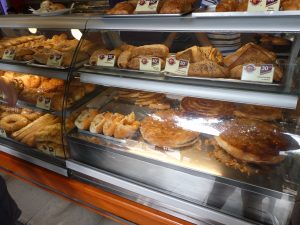
We finally reached the pastry shop preferred by Jane where we grabbed an outside table. Jane proceeded to order yogurt and 4 kinds of “burek”: traditional meat, traditional cottage cheese, spinach and cottage cheese and a new flavour, pizza (which turned out to be my favourite). We also had a very bizarre pastry called simit which was a bun stuffed with phyllo. Seriously. Nothing else. Dough filled with dough. It was bizarre and while not my cup of tea, is apparently very popular here.
The burek, on the other hand, was quite good as was the yoghurt. Anyway, as we were eating, I had the great misfortune to see some poor old guy riding a motorcycle try to do a u-turn on the road only to take the turn too sharply. Next thingy you know, the motorcycle is rolling onto its side with the guy underneath. Thankfully, he was OK, but had horrible road rash all down one side of him. His shirt was in complete tatters. Not the way I would want to start my day.
Anyway, after the tasty and somewhat eventful breakfast, we walked back towards Alexander Square where Jane told me a little bit about Macedonian history. The original borders of ancient Macedonia include the northern region of Greece, the southern region of Bulgaria as well as the existing country of Macedonia. However, over the years, other countries have assimilated portions of ancient Macedonia simply because Macedonia has always been conquered and not really the conqueror. In other words, no ability to conquer or defend on its own. In fact, the Macedonians have been conquered by the best of them. Alexander the Great, the Byzantines and of course, the Turks with their massive Ottoman Empire.
When the Ottoman Empire fell, Macedonia as we know it today was absorbed into what was then Yugoslavia. During World War II, Tito promised the Macedonians if they joined forces with Yugoslavia to defeat the Germans, he would grant the Macedonians their own homeland. True to his word, in 1945 the country of Macedonia was created on Tito’s order and on September 8, 1991, Macedonia gained independence from Yugoslavia.

Macedonia remains known today as a Balkan country, along with other countries that once made up the former Yugoslavia, including Serbia, Croatia, Bosnia and Herzegovina, Kosovo, Slovenia, and Montenegro. While Macedonia enjoys a fairly good relationship with its Balkan neighbors, Macedonia’s relationship with it border neighbor Greece, is not always the best. The tension arises from both the fact that Macedonia has a close relationship with Turkey (and Greece does not) and the fact that Macedonia claims the name Macedonia, which the Greeks believe belongs to them and should only be used to describe the northern area of Greece. In fact, Greeks objections to the use of the name Macedonia has been so strenuous that it has prevented Macedonia from becoming both a NATO and EU member. And while the dispute was recently resolved with the Greek and Macedonia governments agreeing that Macedonia would rename itself North Macedonia, the resolution pissed off the citizens of the two countries. The Greeks believe there should be no country named Macedonia and the Macedonians believe there is no place for compromise.
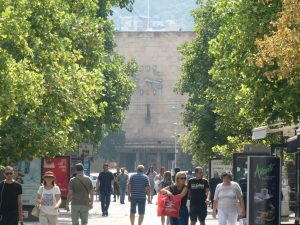
Anyway, with this background, Jane and I began our tour of Scopje. Now much of Scopje was destroyed in a devastating earthquake in 1963 so a lot of the buildings have either been reconstructed or are simply new. In 2014, the government of Macedonia embarked on something called Scopje 2014 which saw the government embark on a massive building campaign that resulted in marble buildings for the arts and government offices and massive statutes in and around Alexander Square. It is an odd combination when you couple it with the ancient Byzantine and Ottoman era historical sites, but I thought it worked quite well.
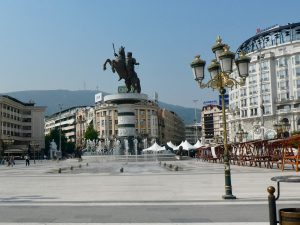
Anyway, we wandered across the massive marble square taking in the huge “Soldier on Horse” aka Alexander the Great statute and fountain and a number of other rather gigantic statutes of famous Macedonian historical figures before crossing the 15th-century Kameni Most (Stone Bridge) to reach the old Scopje historical district with its old Turkish bazaar. I knew we had reached the bazaar the minute I saw the old cobblestone streets and maze of winding alleys.

We walked past old Turkish teahouses, craft shops, tailors and of course, lots and lots of jewelry stores. At one point, we stopped for some Turkish tea and it was as good as I remember from my time in Turkey. Super strong with a hint towards bitter softened by a lump of sugar. And of course, the tea came in that cute little hour glass cup. Love me some Turkish tea!!
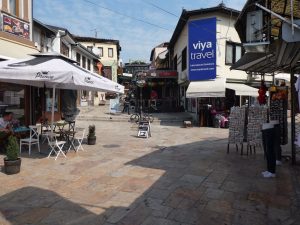

After the tea break, we continued our trip through the bazaar before ending up in the green market also known as the Bit Pazar, a place for all things vegetable. And of course, it being the harvest time here in Macedonia, the market was filled to the rafters with fresh produce from throughout Macedonia. The big seller here is peppers and tomatoes. They were everywhere. Fresh, dried, pickled, sauced. I think I saw everything but frozen. And with fresh produce there was an abundance of spices. Love. Love. Love. Markets.

As we wandered the narrow lanes of the market, I ran into Joan and Pat (the two ladies from Toronto) who were on their own tour. It was lovely to see them again and find out that they too were enjoying their time in Scopje.
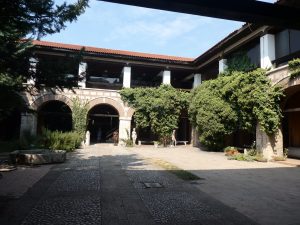
After saying goodbye, Jane and I briefly left the bazaar to take in a couple sites that folks often miss: the ancient inns or caravan serais used as resting spots for the traders of ancient times. Fortunately, three of the inns survived the Scopje earthquake and were very near the bazaar. The first had been near the teahouse we visited earlier, but did not take in. However, we would go visit the other two. To reach the first, we had to walk a short distance down a narrow cobblestone road before reaching the old building known as Suli An. The two-story building had been constructed in a square shape, with a large open courtyard so typical of ancient caravan serais. The building now housed the Scopje Faculty of the Arts. The place literally oozed of history.
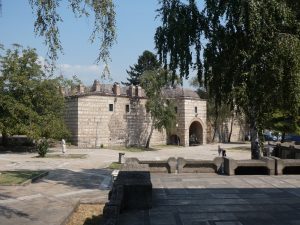

And while the Suli An was lovely to visit, the the second building was far more impressive. Our walk to the third caravan serai took us up a narrow cobblestone hill and through a courtyard surrounded by trees. The building formerly known as Kuršumli was gorgeous made out of ancient stone and brick construction and was huge. Apparently the building had rooms for sixty guests and stables for hundreds of horses. And the fact that the building survived the earthquake is certainly a testament to the ancient stone masons who constructed the building. The only down side was that the front door was locked so I could only peak at the lovely interior through the old wooden doors that were fortunately for me, falling apart.
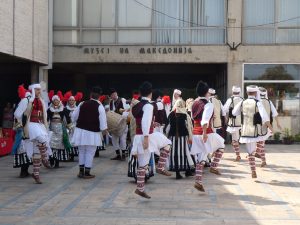
As we turned to leave, I heard music. As luck would have it, we stumbled upon a folk music concert. Two groups: the Ensemble of Macedonia and a group from Eastern Macedonia. The music and costume was a traditional as they come and the dancers and musicians ranged in age from very young to very old. We stayed long enough to watch three different dances and hear some traditional local music using traditional Macedonian instruments. I have to say the music reminded me of Turkish music that I heard in the wedding I saw in the little town I stayed in near Ephesus. And of course, it makes since given the heavy Ottoman influence.
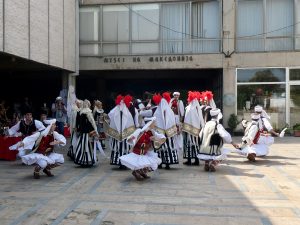
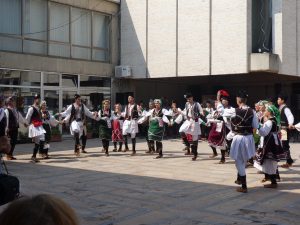
The entire show was wonderful, but the most impressive part of the show was a an elderly gentleman who kept squatting and thrusting his legs out in front of him ala a Cossack dancer. It was unbelievable and the guy had to be at least 70 or more. Gesh. I have a hard time bending over when I get up in the morning.
The only part of the concert I found unfortunate was the fact that there was virtually no one there to watch. There was maybe thirty or so tourists like me who simply stumbled upon the little show while not more than 10 minutes away there were hordes of tourists wandering the bazaar oblivious to the concert. I asked Jane about this and all he could say is that there is very little coordination of such things with the tour guides. Pity. It was a really impressive show as the video below shows.
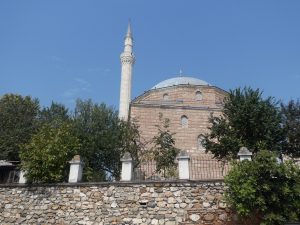
Anyway, we left the concert after the third dance and wandered up yet another cobblestone alley to the Mustafa Pasha Mosque. The Islamic culture has a heavy presence in the country because of the Ottoman Empire (although there is also a heavy Christian Orthodox presence because of the Byzantine rule). The mosque dominates the hillside and can be seen from a variety of locations in Scopje. However, because it was Friday and Friday prayers were just beginning, the best we got to see was the impressive stone exterior.
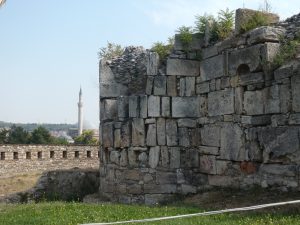

We then crossed the street and wandered up yet another rather steep hill (made all the more difficult by the incredibly hot weather) to the Tvrdina Kale Fortress, which has guarded Skopje’s since the 5th century. There is not much left of the old fortress except exterior walls, but the views to the city below were incredible. In addition, there were incredible remnants of artifacts lying everywhere. Pieces of ancient Roman water pipes, stone wheels and tablets along with pieces of broken vases and artwork were piled up against a shed and all around the grounds. Jane said that because the pieces were remnants, they were not being preserved. Yikes.

After our little hike around the fortress wall, we walked back down the hill to the St. Saviour Church which dates to the 14th century. Now the exterior of the church was nothing like I have ever seen. We walked through the gate and into a very small squareish courtyard surrounded by lots of green. There was no sign of a place of worship. Uh where’s the church? Well apparently because the Ottomans banned churches from being taller than mosques, the clever Christians built the church 2 metres underground. As a result, the sunken design fools you into thinking there is no church.

However, once inside, the church is on full display. Beautiful frescoes on the ceiling and walls. Dark wood carvings displaying religious scenes. And, of course, the gold icons found in every Orthodox Church depicting important figures in the Christian religion. At one point, the caretaker came inside and give me a really quick and surprisingly in depth history of the church. It was a lovely added bonus.
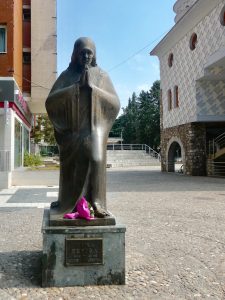
By now it was close to 1:00 p.m. and we have been on the move for almost 4 hours. We had one more stop to make before lunch: the Mother Teresa house. Mother Teresa was born in Scopje and while she moved away at a young age, never forgot her roots. Mother Teresa came back to Scopje on four separate occasions and the house where she was raised has been rebuilt into a museum that includes a myriad array of pictures, furniture and awards Mother Teresa received during her lifetime.
So in order to reach the site, we had to retrace our steps through the bazaar, walk back across the stone bridge through the square and down another one of the narrow pedestrian streets. Outside the museum was a large Mother Teresa statute. We then walked up a staircase to the interior. And while the displays and memorabilia inside were lovely, the best part was the lovely the little chapel on the second floor dedicated to Mother Teresa’s memory. It was built of glass and was literally bathed in light. It was a really happy little place.

So after the visit to Mother Teresa’s house, it was time for lunch. Now Jane had been singing the praises of some little restaurant all morning so my curiosity was peaked. We headed back down the street to meet Dean who would be driving us to the restaurant. However, as we walked we encountered yet another accident. This one happened just behind as a a guy on one of those motorized scooters rant head first into a cyclist. We heard the crash and turned around to see the cyclist splayed out on the concrete. And based on the expletives coming out of his mouth, we figured he would be fine and did not need help so we continued on.
We met Dean on a side street in the van and were whisked across the city and to the outskirts of town. Next thing I know, we are driving down a narrow little dirt road past what appears to be rather run down buildings. However, I no sooner began to wonder where the heck we were going than we pulled up to a little parking lot facing a high wooden fence. Through the door opening I could see a lovely little courtyard. Well this looked interesting.
We hopped out of the van and walked through the doorway into a beautiful little outdoor restaurant. We were quickly seated. The guys exchanged a few Macedonian words with the waiters and before I could finish a glass of water, guys are bring out meze and wine. First up the largest tomato I have ever seen cut up in wedges, some fried zucchini, grilled red peppers with olive oil, cucumber wedges, an egg, cottage cheese and pepper combo, a pepper relish, cheese and bread. Good grief. This was just the apps for lunch! However, the main course was truly an amazing tasting tour. Lamb chops, lamb shank and grilled beef patty (not like hamburger though). The lamb shank had been braised for hours and literally fell apart as I reached for a piece with my fork. The lamb chops were seasoned with salt, pepper and what I thought might be oregano. Both dishes were done to perfection. In fact, the lamb was hands down the best lamb I have ever had in my life. (And I am generally not a huge lamb fan.).
Apparently Jane just learned of this place recently. The restaurant tdoesn’t advertise and is so out of the way that it is often inhabited by politicians and famous Macedonians who want some privacy. Whatever the case, I will never forget that meal. Unfreakinbelievable!
By the time lunch was over, I could barely move. (I was at this point very glad we had walked almost 12,000 steps today as I needed to have done something to burn off the food.). Thankfully, the last stop of the day was going to be an easy one: the Skopje Aqueduct about 2 km outside of town.

The Skopje Aqueduct is the only aqueduct in Macedonia, and is considered one of the best preserved in the world. The aqueduct is made out of ancient stone and brick with 55 arches and approximately 386 meters of wall remaining.
Now no one is apparently quite sure about the history of the aqueduct. It may be Roman dating to the 1st century, or it may be Byzantine having been built by Emperor Justinian I dating to the 6th century, or it may be Ottoman dated to the 16th century. It seems to me it should be pretty easy to figure out by simply carbon dating the bricks and stone. I have no idea why that hasn’t happened, but Jane confirmed that no one knows the origins. Anyway, the aqueduct remained in use until the eighteenth century and apparently carried water from a spring about 9 kilometers (5.6 mi) northwest of Skopje to the city center. Whatever its orgins, it was one impressive aqueduct.
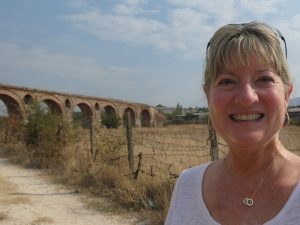
After the visit to the aqueduct, we returned to the city for a bit of a rest before Jane was to pick me up for dinner. Yep. More eating. Fortunately, the meal did not involve meze. We opted for two salads and a couple of pork dishes before calling it a night. While I may not want to eat again, tomorrow promises more delicious food as I move on to Ohrid.
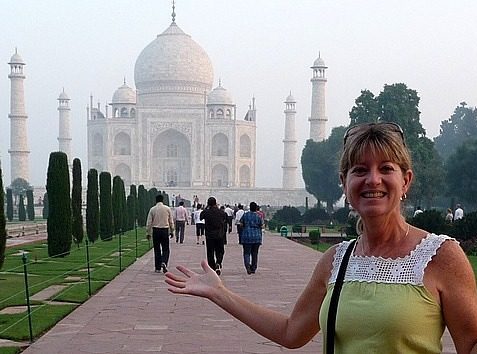
It sounds like a lot of eating! Glad you arrived safely and enjoying yourself!
It is unbelievable the amount of food they keep putting in front of me.
Getting hungry just reading this! Food and sights sound amazing.
Carbon dating relies on analysis of the decay of carbon in ancient artifacts or organic remnants. Since bricks and stones contain no carbon molecules
carbon dating is not possible.
Of course. How silly of me. Thanks for taking the time to point this out Sean!